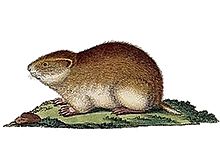West Siberian lemming
| West Siberian lemming | |
|---|---|

| |
Conservation status
| |
| Scientific classification | |
| Kingdom: | Animalia |
| Phylum: | Chordata |
| Class: | Mammalia |
| Order: | Rodentia |
| Family: | Cricetidae |
| Subfamily: | Arvicolinae |
| Genus: | Lemmus |
| Species: | L. sibiricus
|
| Binomial name | |
| Lemmus sibiricus (Kerr, 1792)
| |

| |
| Siberian brown lemming range (includes range of East Siberian lemming) [2] | |
| Synonyms | |
|
Lemmus lemmus chernovi Spitsyn et al., 2021 | |
The West Siberian lemming or Western Siberian brown lemming (Lemmus sibiricus) is a true lemming species found in the Russian Federation. Like other lemmings, it belongs to the Cricetidae family of rodents.
It is endemic to Russia, where it has a wide range throughout Siberia, from the region just south of the White Sea east all the way to the Verkhoyansk Range, which serves as a barrier between it and the East Siberian lemming (L. paulus), which was formerly considered conspecific with it.[3][4]
An insular population inhabits Novaya Zemlya; a 2021 study which performed genetic analysis on the mtDNA of the Novaya Zemlya population found them to group with the Norway lemming (L. lemmus) despite their similar appearance to mainland L. sibiricus, and classified them as the subspecies L. l. chernovi, or Novaya Zemlya lemming. However, the American Society of Mammalogists rejected these results pending further evidence, stating that these more likely represented L. sibiricus with ancient mitochondrial introgression from L. lemmus (see the article for L. lemmus for further info).[5]
It does not hibernate during winter; it lives in burrows. It is prey to several animals, including the snowy owl and the Arctic fox. As with other species of lemmings, Siberian browns routinely experience large-scale fluctuations in their population sizes.[6]
References[]
- ^ Tsytsulina, K.; Formozov, N. & Sheftel, B. (2017) [errata version of 2016 assessment]. "Lemmus sibiricus". IUCN Red List of Threatened Species. 2016: e.T11482A115102530. doi:10.2305/IUCN.UK.2016-3.RLTS.T11482A22336110.en. Retrieved 19 February 2022. Database entry includes a brief justification of why this species is of least concern.
- ^ IUCN (International Union for Conservation of Nature) 2008. Lemmus sibiricus. In: IUCN 2014. The IUCN Red List of Threatened Species. Version 2014.3. http://www.iucnredlist.org. Downloaded on 22 March 2015.
- ^ "Explore the Database". www.mammaldiversity.org. Retrieved 2021-09-05.
- ^ Spitsyn, Vitaly M.; Bolotov, Ivan N.; Kondakov, Alexander V.; Klass, Anna L.; Mizin, Ivan A.; Tomilova, Alena A.; Zubrii, Natalia A.; Gofarov, Mikhail Y. (2021-03-17). "A new Norwegian Lemming subspecies from Novaya Zemlya, Arctic Russia". Ecologica Montenegrina. 40: 93–117. doi:10.37828/em.2021.40.8. ISSN 2336-9744.
- ^ "Explore the Database". www.mammaldiversity.org. Retrieved 2021-09-05.
- ^ Korpimäki, Erkki; Brown, Peter; Jacob, Jens; Pech, Roger (2004). "The Puzzles of Population Cycles and Outbreaks of Small Mammals Solved?". BioScience. 54 (12): 1071–1079. doi:10.1641/0006-3568(2004)054[1071:tpopca]2.0.co;2.
Further reading[]
- Musser, G. G. and M. D. Carleton. (2005). Superfamily Muroidea. pp. 894–1531 in Mammal Species of the World a Taxonomic and Geographic Reference. D. E. Wilson and D. M. Reeder eds. Johns Hopkins University Press, Baltimore.
- IUCN Red List least concern species
- Lemmus
- Mammals described in 1792
- Arctic land animals
- Mammals of the Arctic
- Mammals of Siberia
- Endemic fauna of Russia
- Arvicolinae stubs
